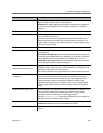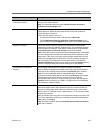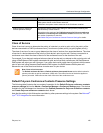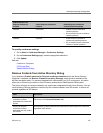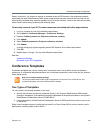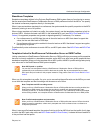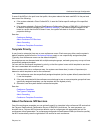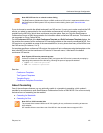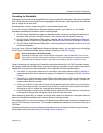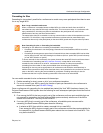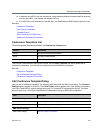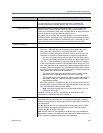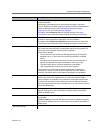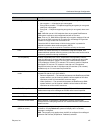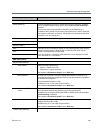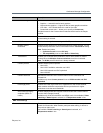
Conference Manager Configuration
Polycom, Inc. 192
Cascading for Bandwidth
Cascading a conference across multiple MCUs to conserve bandwidth is especially useful when using WAN
links. Participants can connect to MCUs that are geographically near them, reducing network traffic between
sites to a single link to each MCU.
Cascading does, however, impact the quality of the conference experience.
If you have a Polycom RealPresence Resource Manager system in your network, you can enable
cascaded-for-bandwidth conferences with the following steps:
1 On the Polycom RealPresence Resource Manager system, create site topology data defining the
territories, sites, site links, and MPLS clouds in your network, and the subnets in each site.
2 On the Polycom RealPresence DMA system, integrate with the Polycom RealPresence Resource
Manager system to obtain its site topology data. See RealPresence Resource Manager Integration.
3 On the Polycom RealPresence DMA system, enable cascading for bandwidth in some or all of your
conference templates.
If you don’t have a Polycom RealPresence Resource Manager system, you must define your site topology
in the Polycom RealPresence DMA system instead of importing it. See Site Topology.
Once a conference with cascading for bandwidth enabled has started (the “hub” MCU has been chosen),
the Polycom RealPresence DMA system uses the site topology information to route callers to the nearest
eligible MCU (using the pool order applicable to the conference) that has available capacity:
● If the caller is in a site that contains one or more MCUs, the system selects an MCU in that site (it
selects the same MCU that it would have chosen in the absence of cascading. See MCU Selection
Process.
● If the caller is in a site that doesn’t contain MCUs, the system looks for MCUs in sites that only have
a direct network path to the caller’s site (no path to the caller’s site through a cloud). It selects one,
using the same selection process.
● If there are no MCUs in sites that only have a direct network path to the caller’s site (no path to the
caller’s site through a cloud), the system looks for MCUs in sites that are connected to the caller’s
site through a cloud. It selects one, using the same selection process.
● If an MCU belongs to an MCU pool, the DMA system selects an MCU that meets the requirements
of the selection process from the highest priority pool within the pool order.
When determining which MCU is “nearest” and which path is best for a cascade link, the system takes into
account the bandwidth availability and bit-rate limitations of alternative paths.
If the selected MCU is new to the conference, the RealPresence DMA system creates the cascade link to
the “hub” MCU hosting the conference. The cascade link bandwidth matches the conference setting, up to
1920 kbps.
Cascaded conferences can have conference passcodes and can be Polycom Conferencing for Outlook
(calendared) conferences (see Microsoft Exchange Server Integration).
Note: Cascading for bandwidth topology
Cascading for bandwidth uses a hub-and-spoke configuration; each cascaded MCU is only one link
away from the “hub” MCU that hosts the conference. To host the conference, the system chooses the
same MCU that it would have chosen in the absence of cascading. See MCU Selection Process.



